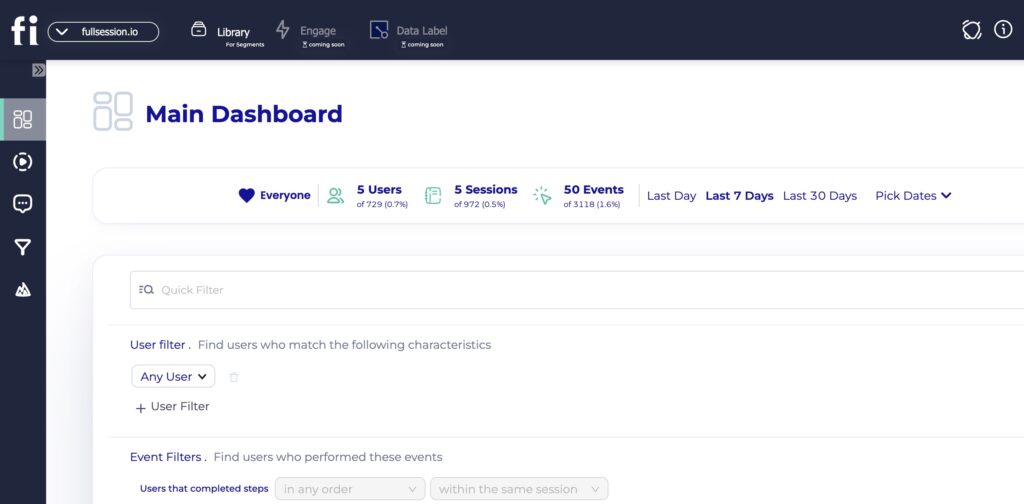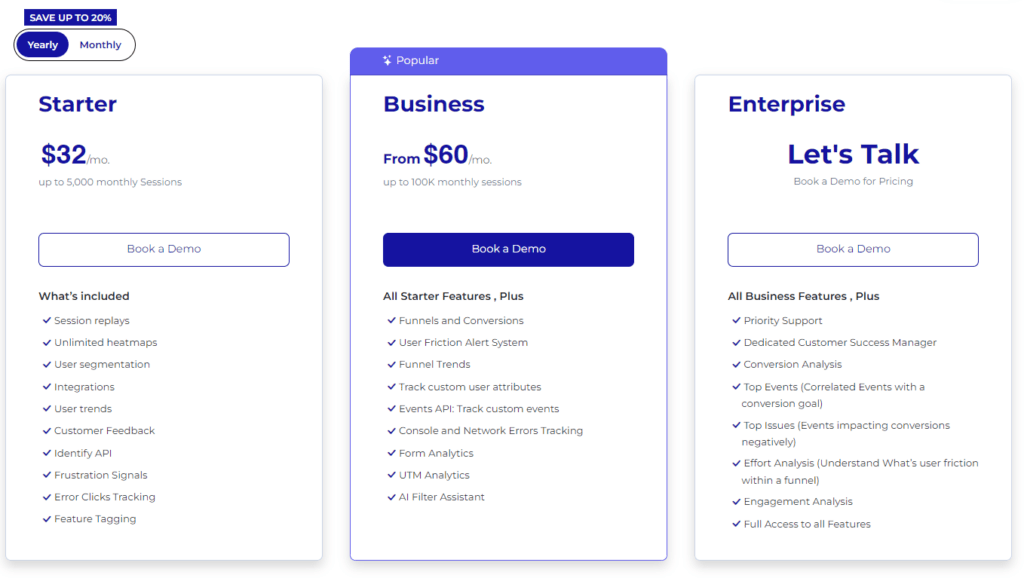Are you looking to optimize your website's performance but unsure if VWO is the right choice? You're in luck! We've compiled...

Differences Between Exit Rate vs. Bounce Rate Explained
The success of your business hinges on more than just attracting visitors to your website. It's about making them stay, engage, and convert. Two critical metrics that give insight into how well your website retains visitors are the bounce rate and exit rate.
In this article, we will see the difference between exit rate and bounce rate, and see what their importance on your business could be.
What is a Website Bounce Rate?
A website bounce rate is a metric that tracks when visitors land on a web page and leave without browsing any other pages. It's a critical indicator for behavioral targeting, as it helps understand user engagement and content relevance.
High bounce rates may suggest that the home page does not meet user expectations or that multiple pages are not effectively drawing visitors deeper into the site. Both can be bad for your business.
What is the Average Bounce Rate?
The average bounce rates can greatly vary by industry and the type of website. Generally, a bounce rate between 26% to 40% is excellent, 41% to 55% is average, and 56% to 70% is higher than average, but may not be cause for alarm depending on the website's purpose.
Anything above 70% is considered high for everything outside of blogs, news, events, etc.
How Can You Calculate The Bounce Rate?
If you want to calculate the bounce rate of a website, you can divide the total number of single-page sessions by the total number of all sessions and then multiply the result by 100.
For example: Site X has 6,500 bounced sessions out of 14,500 total sessions for. The bounce rate would now be approximately 44.83%. So it indicates that nearly 45% of all sessions on the site consist of single-page visits without further user interaction.
What is Exit Rate?
Exit rate is the metric that indicates the percentage of times a specific web page is the last in a session before a visitor leaves a site.
It offers quantitative data to help identify pages where users are dropping off, which can signal the need to optimize for better retention and guide improvements in the site's overall navigation and content strategy.
Why Is Exit Rate Important for You?

Exit rate is a critical metric, especially for pages where you expect higher engagement, such as e-commerce confirmation pages. It provides insights into the last page users visit before leaving your site, and might indicate problems in advance.
When you analyze the exit rate of a particular page, you can identify whether that page effectively retains visitors or needs improvement. High exit rates on certain pages may indicate issues with content, navigation, or user experience. Or (hope not), all three.
Comparing the exit rates of different pages helps in learning user behavior across your site. It reveals which pages are performing well and which are not, which guides you in improving the user journey.
How To Calculate The Exit Rate?
To calculate the exit rate for a specific page on a website, divide the total number of exits from that page by the total number of views the page received. Multiply the result by 100 to get the exit rate as a percentage, to reflect the frequency of users leaving from that page.
For example: Let's consider a webpage on your site that has about 10,000 interactions (pageviews) in total. The visitor exited the pages 3,000 times, so you will have 30% exit rate in total.
Exit Rate vs Bounce Rate: What Are the Differences?
Exit rate and bounce rate are different metrics but they both shed light on the crucial aspects of the user behavior on your website.
-
Exit rates measure the percentage of exits from a particular page, regardless of the session's length.
-
The bounce occurs when a session consists of just one pageview, typically the landing page, but it's not limited to it. It may be a blog page, or a product page.
-
A high exit rate on exit pages can indicate a natural end to a browsing session. The bounce rate is exactly the opposite.
-
Bounce rates reflect initial engagement and reveal if the landing page resonates with visitors.
Why Track Exit and Bounce Rates?

Knowing why visitors leave is as crucial as knowing why they stay. If you track these metrics, you can:
-
Identify pages that are underperforming, or not performing to your expectations.
-
Gain more in-depth insights into customer behavior and user preferences.
-
Optimize content and design to leverage the user engagement.
-
Improve navigation to keep users on your site longer.
How to Track Your Website's Exit Rate?
To effectively track your website's exit rate, it's crucial to understand user interactions and when they decide to leave. Let's see how to do it in a couple of steps.
1. Analyze User Journey
Begin with Google Analytics to gauge the frequency of single-page sessions. Insight into one-page visits can highlight whether your content aligns with visitor expectations and where to focus optimization efforts.
2. Integrate Tracking Tools
Set up Google Analytics to observe exit rates and identify common exit pages. The data can pinpoint where users are likely to leave and help you refine those pages and boost user retention.
3. Evaluate User Engagement

Incorporate tools like FullSession for deeper insights. Our platform goes beyond just numbers; it offers visual context to not all exits signify a product feedback experience, and can help distinguish between a natural session conclusion and areas that require improvement.
How to Decrease Your Exit Rates?
If you want to boost your exit rates, then you have to work on your websites. Here are 5 quick tips to do the job.
1. Optimize for Mobile Customers
Optimizing your website for mobile users is absolutely paramount for your site's success. Responsive design on mobile devices plays a vital role in engaging users and preventing frustration.
Such a strategy involves ensuring that your site displays and functions seamlessly on various screen sizes.
By doing so, you reduce the likelihood of users leaving due to poor mobile compatibility, thereby potentially decreasing exit rates.
2. Streamline Navigation
Streamlining your site's navigation is crucial. Ensure it's clear and intuitive, with menus and layouts that don't cut corners but are spot on in guiding users.
A user-friendly interface greatly reduces confusion and inefficiency, thereby minimizing exits.
That approach not only simplifies the user journey but also enhances overall engagement, making for a smoother, more enjoyable browsing experience.
3. Improve Content Relevance
Keeping your site's content current is crucial. Fresh material reflects an active and updated platform, enticing users to return.
Content relevance cannot be overstated. It ensures that visitors find what they're looking for, reducing the likelihood of quick exits.
Value-driven content is key. It engages users, encouraging them to explore further and stay longer on your website.
4. Boost Loading Speed
Page loading speed is a critical factor in website performance. Quick load times are essential for retaining visitors and decreasing exit rates.
Efficiently loading web pages cater to the fast-paced expectations of modern web users. Delays can frustrate users, prompting them to exit prematurely.
Optimizing your website's loading speed is therefore essential. It boost user experience, potentially reducing exit rates and improving overall engagement.
5. Address Page Design
Poor page design can significantly contribute to high exit rates, although not everyone comes to that conclusion.
Strategic design enhances user experience and makes it more likely for visitors to engage with the site's content deeply.
A well-crafted page design is not just visually appealing but also intuitive, but it also guides users through the content flow and encourages them to stay longer.
How You Can Boost Your Exit Rate and Bounce Rate Today
It takes less than 5 minutes to set up your first website or app feedback form, with FullSession, and it’s completely free!
FullSession Pricing Plans

Here are more details on each plan.
- The Starter plan costs $39/month or $32/year and allows you to monitor up to 5,000 monthly sessions with up to 6 months of data storage.
- The Business plan costs $75/month or $60/year and helps you to track and analyze up to 100,000 monthly sessions with up to 12 months of data storage.
- The Enterprise plan has custom pricing and offers customizable sessions plus full access to all features.
Conclusion
In conclusion, monitoring and reducing the exit rate is vital for enhancing site quality.
When you target specific pages with high exit rates and employ tools like FullSession to identify user patterns, you can proactively improve user experience.
FAQs In Relation to Exit Rate vs Bounce Rate
What are bounce and exit rates and how do they differ?
Bounce rate is the percentage of visitors who leave your website after viewing only the landing page, without any further interaction. Exit rate, on the other hand, measures the percentage of exits from a particular page, considering all visits to that page regardless of how many other pages were viewed in the session.
How can I tell if my bounce rate is too high?
Compare your bounce rate to industry averages. If it's significantly higher, it may be time to investigate and optimize your entrance pages.
Is a high exit rate always bad?
Not necessarily. If the exit occurs after a conversion or completing a desired action, it might not be bad for you.




